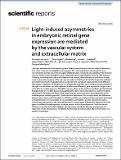Light-induced asymmetries in embryonic retinal gene expression are mediated by the vascular system and extracellular matrix
Abstract
Left–right asymmetries in the nervous system (lateralisation) influence a broad range of behaviours, from social responses to navigation and language. The role and pathways of endogenous and environmental mechanisms in the ontogeny of lateralisation remains to be established. The domestic chick is a model of both endogenous and experience-induced lateralisation driven by light exposure. Following the endogenous rightward rotation of the embryo, the asymmetrical position in the egg results in a greater exposure of the right eye to environmental light. To identify the genetic pathways activated by asymmetric light stimulation, and their time course, we exposed embryos to different light regimes: darkness, 6 h of light and 24 h of light. We used RNA-seq to compare gene expression in the right and left retinas and telencephalon. We detected differential gene expression in right vs left retina after 6 h of light exposure. This difference was absent in the darkness condition and had already disappeared by 24 h of light exposure, suggesting that light-induced activation is a self-terminating phenomenon. This transient effect of light exposure was associated with a downregulation of the sensitive-period mediator gene DIO2 (iodothyronine deiodinase 2) in the right retina. No differences between genes expressed in the right vs. left telencephalon were detected. Gene networks associated with lateralisation were connected to vascularisation, cell motility, and the extracellular matrix. Interestingly, we know that the extracellular matrix—including the differentially expressed PDGFRB gene—is involved in morphogenesis, sensitive periods, and in the endogenous chiral mechanism of primary cilia, that drives lateralisation. Our data show a similarity between endogenous and experience-driven lateralisation, identifying functional gene networks that affect lateralisation in a specific time window.
Citation
Versace , E , Sgadò , P , George , J , Loveland , J L , Ward , J , Thorpe , P , Jensen , L J , Spencer , K A , Paracchini , S & Vallortigara , G 2022 , ' Light-induced asymmetries in embryonic retinal gene expression are mediated by the vascular system and extracellular matrix ' , Scientific Reports , vol. 12 , 12086 . https://doi.org/10.1038/s41598-022-14963-8
Publication
Scientific Reports
Status
Peer reviewed
ISSN
2045-2322Type
Journal article
Description
Funding: This project was supported by BBSRC Grant BB/S003223/1 (EV, JG), Royal Society Grant UF150663 (SP), Novo Nordisk Foundation Grant NNF14CC0001 (LJJ), ERC Horizon 2020 Grant Agreement 833504 SPANUMBRA, PRIN 2017 and ERC-SH4-A (2017PSRHPZ) to GV.Collections
Items in the St Andrews Research Repository are protected by copyright, with all rights reserved, unless otherwise indicated.

